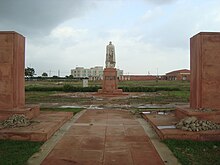| Coronation Park | |
|---|---|
| India | |
 Distant image of Former Viceroy Lord Chelmsford's statue at the park | |
| For Coronation of the King George V to proclaim him Emperor of India | |
| Unveiled | 1911 |
| Location | Delhi28°43′23″N 77°11′49″E / 28.723006°N 77.196892°E |
Coronation Park is a park located at Burari Road near Nirankari Sarovar (Formless Lake) in Delhi, India. It was the venue of the Delhi Durbar of 1877 when Queen Victoria was proclaimed the Empress of India. Later it was used to celebrate the accession of King Edward VII in 1903, and, finally, it was here that the Durbar commemorating the coronation of King George V as Emperor of India took place on 12 December 1911, subsequent to his coronation at Westminster Abbey in June 1911. This last celebration had all the princely states in attendance. The decision to hold the Coronation Durbars in Delhi at the vast open ground at Coronation Park was a move to emphasise the historical significance of Delhi as the former capital of the Mughal Empire.[1][2][3][4]
Coronation Park has the largest and tallest statue of King George V. The statue was moved here in the mid-1960s from a site opposite India Gate in the centre of New Delhi. It is opposite the Obelisk called the Coronation Memorial, which commemorates the 1911 Durbar, when George V laid the foundation stone for the new capital city of New Delhi.[1][2][5][6]
- ^ a b "A monumental delight for Delhites". The Hindu. 19 September 2005. Archived from the original on 9 March 2008. Retrieved 6 June 2009.
{{cite web}}: CS1 maint: unfit URL (link) - ^ a b Charlotte Corey (29 December 2002). "The Delhi Durbar 1903 Revisited". Sunday Times. Archived from the original on 13 May 2009. Retrieved 6 June 2009.
- ^ Lucy Peck (2005). Delhi – A thousand years of Building. New Delhi: Roli Books Pvt Ltd. p. 241. ISBN 81-7436-354-8. Retrieved 6 June 2009.
Though Calcutta was the capital, Delhi's historical significance persuaded the British to hold three Durbars here. The first was the imperial assemblage of 1877, which brought 70,000 people into Delhi, followed by the two coronation durbars of 1902–03 and 1911–12, both attended by even more people and the second by the King and Queen themselves. Each one was held at the same spot on open ground to the north of the Cantonment area. The encampments of all those attending spread for miles. The Viceroy and Governors of the various provinces were camped where Delhi University now stands and a light railway connected them with the Civil Lines in one direction and the Parade Ground and Proclamation dias on the other.
{{cite book}}:|work=ignored (help) - ^ Datta, Rangan (24 January 2022). "Coronation Park: Delhi's graveyard of colonial statues". The Telegraph. My Kolkata. Retrieved 16 October 2023.
- ^ Jeffrey N. Dupée (2008). Traveling India in the Age of Gandhi. University Press of America. p. vii. ISBN 978-0-7618-3949-1. Retrieved 6 June 2009.
{{cite book}}:|work=ignored (help) - ^ "Coronation park: legacy of the Raj". The Indian Express. 27 November 2008. Retrieved 6 June 2009.
© MMXXIII Rich X Search. We shall prevail. All rights reserved. Rich X Search
